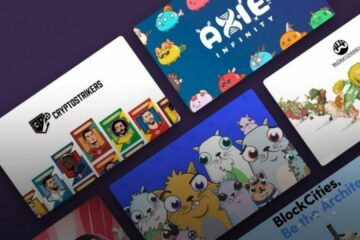The first step in creating an NFT is to create your crypto address on Ethereum.
Ethereum is a global, open source platform and decentralized blockchain system that has its own cryptocurrency: Ether.
Start by downloading a wallet (digital wallet) among all those on the market to allow you to send and receive cryptocurrency. It is this “crypto wallet” that will store the ethereum. Among the services, you can try MetaMask which is available as a browser and mobile app extension. Then all you have to do is connect your wallet to an NFT marketplace.
Cost of creating and selling an NFT
When your digital wallet is set up, you can buy ETH with Apple Pay or your bank card. Platforms don’t often charge a registration or creation fee, but there are transaction fees associated with selling an NFT. These fees vary depending on the value of the ether and are not to be taken lightly when pricing your NFT.
Allow at least $100 of Ether to be on your wallet, but the process can cost you more depending on the variations.
Choose an NFT marketplace
Now that you are ready to spend your ether, you can connect your digital wallet to a platform to create your NFT.
You can compare NFT marketplaces to platforms like Etsy or Ebay except that you will only find digital products there. So designers and artists can sell their digital works on these marketplaces.
Here is a list of the platforms on the market to create and sell your NFT.
Opensea
You can quickly and easily create your digital token on this market-leading platform. Opensea does not require any coding knowledge and is very easy to use.
The platform has over 142,000 NFTs to date and attracts many buyers. You should take into account the ETH transaction fees when selling your NFT.
Opensea offers advanced features such as the ability to sell NFTs in batches with digital products from other vendors.
Rare
Raise, sell and collect NFTs on Rarible, a platform interconnected to Opensea which also generates a lot of traffic.
However, you are limited in the size of the illustrations unlike Opensea. Otherwise the process for creating and selling your NFT remains the same.
When integrating your file, you can also add content accessible only after the sale of the NFT as a code or link!
Mintable
This is the cheapest platform if you want to test the process. Indeed, you can create your cryptographic token at no cost, which is a clear advantage of this marketplace.
The pandemic has accentuated or provoked in some a crisis of meaning, but it has also enabled a majority of young people to fill their stockings! In the United States, 65% of 18-39 year olds believe that the crisis has had a positive impact on their finances by avoiding overconsumption, according to a recent study carried out by the specialized site Money Under 30.
Above all, this generation says it is ready to invest this savings, now and in the markets. What is newer, say the authors of the study, especially in a hectic stock market year.
In 2020, 400,000 new investors took their first steps on the stock market, according to the Autorité des marchés financiers (AMF). This appetite is illustrated by the success of trading applications, like Robinhood, which has around 22 million aficionados across the Channel.
The phenomenon is gradually reaching the Old Continent. French fintech Lydia, which affects 30% of 18-30 year olds, announced on November 22 that it was embarking on trading. Its 5.5 million users will now be able to buy and sell stocks, ETFs, precious metals and especially cryptocurrencies.
In the United States, nearly half of millennials have crypto. The same will happen in Europe, “said” Echoes “Cyril Chiche, boss of Lydia. According to the report from crypto.com published in July 2021, the number of users has doubled in six months and, over the same period, bitcoin has seen its price increase by 25%.
Twenty-two-year-old Charlie is one of the recent insiders. In January 2021, his first salary for a 3D graphic designer in his pocket, he turned to cryptocurrencies, but not only for money: “I’m interested in understanding how the blockchain works behind cryptocurrencies and the solutions that it offers. this will bring in the future. On the advice of a friend who invests, the young graduate bet on bitcoin and ethereum, the two most common currencies. Left with 2,500 euros, his wallet now shows 3,500.
The rise of NFT
As with the video games Charlie is a fan of, the blockchain is full of rules to learn and share with friends. It is even more obvious for NFTs (non-fungible tokens), these unique virtual objects resold for thousands of euros with their certificate of authenticity. Based on the blockchain, these rare gems take on easily identifiable forms on the Internet: drawings, pieces of music, photos or works of art of all kinds … Recently, for example, Booba published an exclusive piece reserved for the owners of its NFTs.
Charles, twenty-five, already had a foothold in investing in the stock market before turning to NFTs: “I have invested in projects in which I believe in and which are followed by a lot of people on Discord and Twitter. I would say it’s a bit of a world of ‘rich geeks’ between twenty and thirty, who are willing to spend thousands of dollars on an image. “For his part, Charlie even made a good deal thanks to Discord:” Some guys said that you could get Karl Lagerfeld sweaters in NFT for free by positioning yourself first. I managed to have five. We always want to be the first on every project. “
This collaborative aspect has upset the relationship of young people to money, analyzes Elodie Gentina, teacher-researcher at IESEG School of Management. “Money is important, but not essential. What matters is not to own but rather to share what we are in the world, on social networks ”, she specifies, going so far as to qualify this generation as“ post-materialist ”.
Train on TikTok
It is also on social networks that young people learn, with the most fashionable influencers. In France, Clément Youdec has, for example, more than 250,000 subscribers on TikTok. There, he shares his knowledge of cryptocurrencies and NFTs and offers paid training to “increase his financial IQ”. In the United States, 41% of Gen Z youth (those born after 1995) say they used TikTok to access financial information in December 2020, according to a study published by LendingTree in January 2021.
A need for instantaneity, sums up Elodie Gentina: “This generation wants to manage their money the same way they order an Uber, with just one click. But while young people are very good at finding information quickly, it is not always verified. “



0 Comments